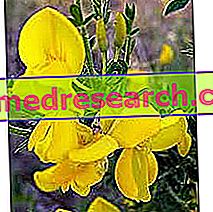
Scientific name
Sarothamnus scoparius
Family
Leguminosae
Origin
Very common plant in the woods
Synonyms
Discovery genista
Used Parts
Drug given both by the aerial parts and by the single flowers of the broom.
Chemical constituents
- Amine (tyramine);
- Flavonoids;
- Sparteina (minimum content 0.8%);
- Alkaloids.
Ginestra in Erboristeria: Properties of Ginestra
In the past the broom was used in the form of tisanes against functional and organic cardiovascular disorders, but also as a diuretic; sparteina, on the other hand, was used as a cardiotonic and antiarrhythmic.
Despite traditional uses, no data are available about the efficacy and safety of broom in the therapeutic field.
Biological activity
As mentioned, the sparteine contained in the broom is exploited for its action exerted on the heart in the treatment of cardiovascular disorders. In fact, spartein is attributed cardiotonic properties, thanks to its ability to exercise chronotropic and inotropic activities. Furthermore, it appears that this molecule is also capable of inducing a transient increase in blood pressure.
However, it is important to remember that sparteine, as well as broom, cannot be part of the composition of food supplements and that the use of sparteine as a cardiotonic can only occur under the strict control of the doctor.
Another molecule contained within the broom is tyramine. This molecule is a sympathomimetic able to promote the release of noradrenaline from neurons, thus causing vasoconstriction and hypertension.
The scoparina, instead - which is a flavonoid contained within the broom itself - is attributed diuretic properties. In fact, broom flowers are easily found in herbal teas that are used just like light diuretic remedies.
However, for more in-depth information on the use of broom in herbal teas, we recommend reading the article dedicated to "Broom of the charcoal burners in herbal teas".
Broom in folk medicine and homeopathy
In folk medicine, broom is a plant that is used to treat a wide variety of disorders. Both aerial parts are used as a whole and flowers only.
More precisely, the aerial parts of the broom are used in traditional medicine for the treatment of: hypotension, edema, cardiac disorders with nervous components, cardiac arrhythmias, gallstones, kidney stones, enlargement of the spleen, gout, jaundice, sciatica and rheumatism.
Furthermore, the plant is also used as a remedy for heavy menstruation, bleeding after childbirth, gum bleeding, bronchial affections and even snake bites.
The broom flowers, on the other hand, are used in folk medicine for the treatment of edema, rheumatic pain, gout, kidney stones, liver disorders (including jaundice) and enlargement of the spleen; as well as being used as a remedy to purify the blood.
The broom is also used in homeopathic medicine, where it is found in preparations both alone and in association with other homeopathic remedies, in order to enhance or complete its activities. The plant is used in homeopathic settings, generally as a draining remedy and has indications for the treatment of heart disease, cardiovascular disorders, urination disorders, bladder diseases, chronic nephritis and rheumatic pains.
The amount of homeopathic remedy to be taken may differ from individual to individual, also depending on the type of homeopathic dilution that must be used.
Side effects
Following the intake of broom - due to the presence of amines with adrenergic activity - vasoconstriction and hypertensive crises can occur, especially if they are already taking drugs that inhibit monoamine oxidases (otherwise called MAOIs).
Contraindications
The use of broom is contraindicated in individuals suffering from arterial or atrio-ventricular blockage and in patients who are already taking MAOI drugs. Naturally, the use of the plant is contraindicated even in the case of ascertained hypersensitivity towards one or more components.
Finally, due to its abortive potential, the broom must absolutely not be taken during pregnancy.
Pharmacological Interactions
- I-MAO: interactions may occur due to the presence of high doses of tyramine.



